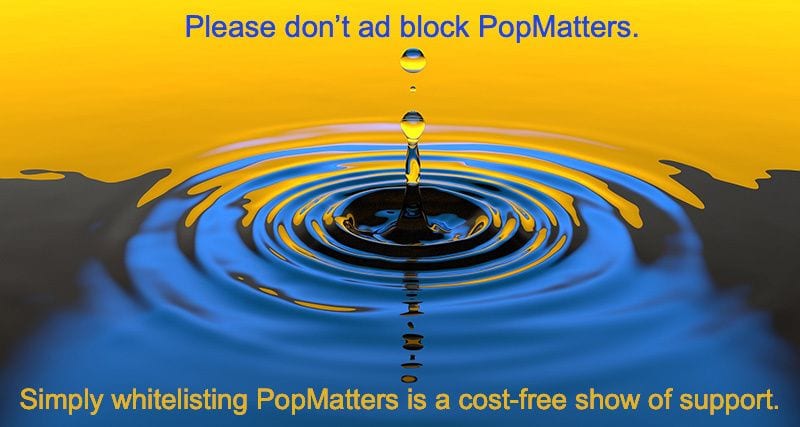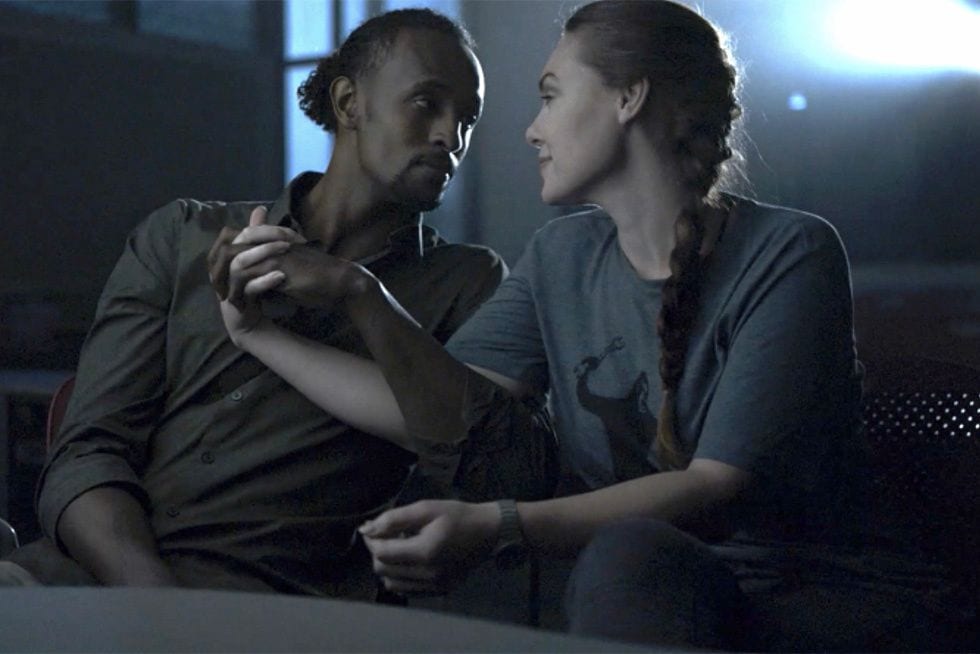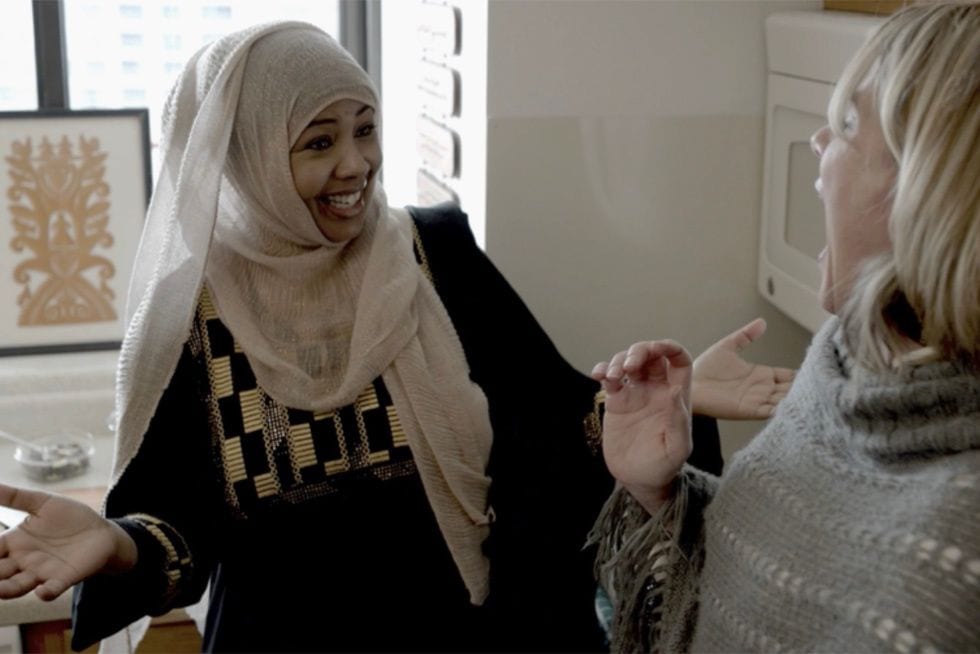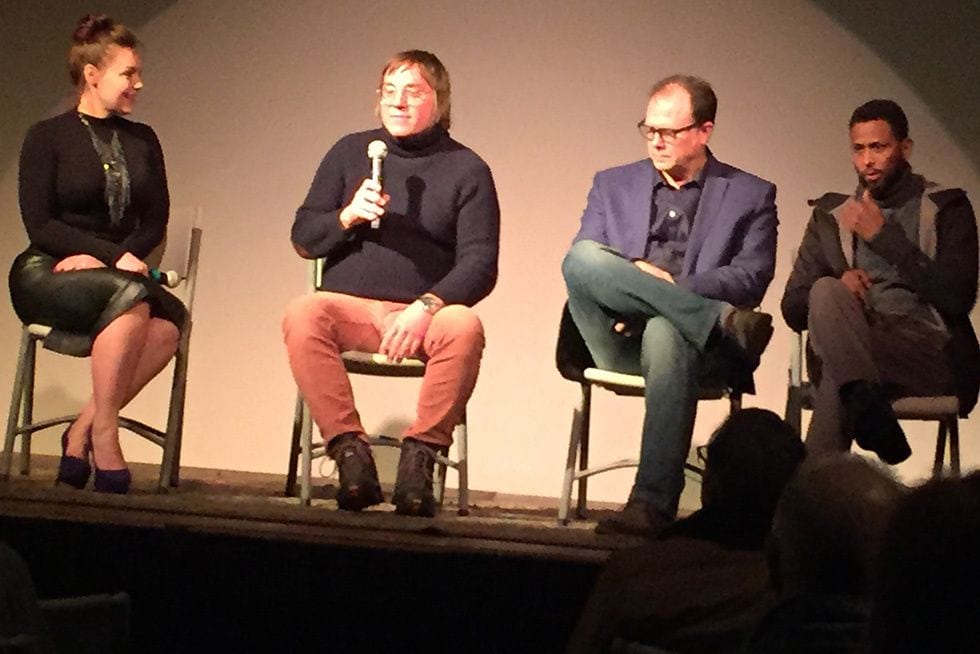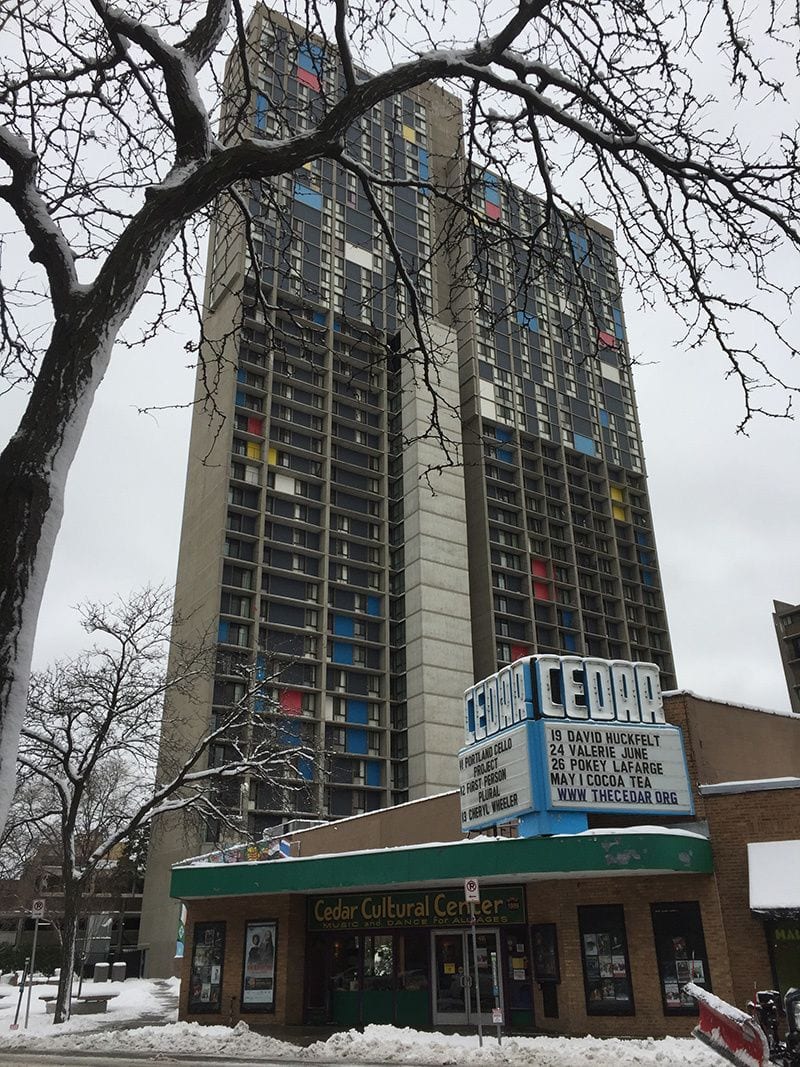Omar (his name has been changed for anonymity) sets up a computer, a stack of forms, some pens, and a mini blue flag with a white star on a table in the corner of the Starbucks on 25th and Riverside in Minneapolis. The iconic Riverside apartments squat in the near distance towering out of the Cedar-Riverside neighborhood, home of the largest Somali diasporic community in the United States. Starbucks’ proximity to these high-rises of over 8,000 people makes it a hub where many Somali elders and male youth congregate throughout the day exchanging pleasantries and gossip from both near and afar.
Omar sits down at the table and explains to me that he was a refugee of the Somalian Civil War during the early ’90s and set up a free service for recent refuges to help them navigate various challenges they confront when first arriving to the United States like using public transportation, finding employment, locating housing, and learning English. When I question him how Starbucks allows him to set up within it, he shrugs his shoulders and offers a wide disarming smile as if no other possibility is an option. He adds matter-of-factly, “I have partners who set up other tables at nearby Starbucks so we can reach different groups of people.”
While chatting, another middle-aged Somali man questions me about what brings me to Minneapolis. I mention that I’m conducting interviews with Muslim-American youth of different backgrounds. I’m talking with them about their grassroots resistance against being stereotyped by commercial media industries as nothing more than terrorists and welfare cheats and being criminalized by local and national law enforcement. He loudly exclaims, “Come on, man. All the time Islam and terrorism. It’s so stereotypical. Can’t they think of something else?” As I soon learned, this was a fairly typical sentiment found among the various Muslim-American communities that populate Minneapolis.
Although some Somali-Americans in the Twin Cities have, unfortunately, been
linked to terrorism, many grassroots Muslim-American organizers stress that Islamophobia is rooted in a much deeper history of white nationalism and settler-colonialism that disenfranchises wide swatches of black and brown communities, Muslim and non-Muslim alike, in different yet related ways. As Hamid Kahn, founder of the Stop LAPD Spying Coalition, notes, “This current moment is an extension of what has always been. This is not a moment in time but a continuation in history” where the use of the Other has always been imposed upon Native Americans, Asian Americans, blacks, Latinx populations, and transgender communities, to name a few, to bolster American imperialism and white privilege (phone interview with author, 6 March 2019). Media representations of such communities play a particularly important role in bolstering the ways in which state resources are administered or deprived, policing is imposed, political power consolidates itself or is challenged, and neighborhoods become integrated as part of the American fabric or ostracized as a sleeper cell waiting to strike.
Somali-Americans, black Muslims, and other Muslim-American groups in the Twin Cities are particularly attuned to the direct impact such negative representations can have. Minneapolis had the sad misfortune of being targeted as one of the three pilot cities (Boston and Los Angeles were the two others) where the Obama administration launched its Countering Violent Extremism (CVE) initiative in 2015. Although couched within seeming neutral and mind-numbingly monotonous bureaucratic language, CVE predominantly targets Muslim-American communities of color in all three cities—with Somali-Americans being a central target in Minneapolis. (See Ramla Bile, “Somali Minnesotans: Survivors of CVE”, Mizna 18, no. 1 (2017) and Faiza Patel and Meghan Koushik, “Countering Violent Extremism”, Brenan Center for Justice (2017)).
Media sensationalism plays a significant part in the targeting of the Somali-American community by federal, state, and local law enforcement. The community remains invisible to commercial media until tragedy strikes through an ISIS attack or an assault by a Muslim-American. Then the media descends and swarms before the Brian Coyle Center, the heartbeat of the Cedar-Riverside neighborhood where countless community activities pulse, as unsuspecting East Africans refuges of all types—Somalis, Ethiopians, Kenyans—are besieged with questions about their opinion on the latest catastrophe as they hustle on their way to work, a meeting, dinner or other engagement.
Minneapolis has the distinct misfortune of having two Somali terrorist-related events galvanize media in the last ten years: in 2008 a group of youth fled the Twin Cities to join al-Shabaab, a state-designated East African terrorist organization, and in 2014-2015 a series of local Somali youth attempted to join ISIS. A media frenzy speculated about the Cedar-Riverside neighborhood being a hotbed of terrorist sleeper cells. An ex-U.S. Senator from Minnesota, Norm Coleman, branded the state as “the land of 10,000 terrorists” (see Ibrahim Hirs, ” Fighting ISIL from City Hall“, Politico, 20 Aug 2015).Trump capitalized upon the moment when running for president while visiting Minnesota and exclaiming, “Here in Minnesota, you’ve seen first-hand the problems caused with faulty refugee vetting, with very large numbers of Somali refugees coming into your state without your knowledge, without your support or approval” (Ben Jacobs, “Somali migrants are a ‘disaster’ for Minnesota, says Donald Trump“, The Guardian, 7 Nov 2016).
Such statements and coverage overlook a series of important facts. The United States is one of the most heavily vetted countries for refugees with a process that takes around two years. The number of foreign-born Muslim-Americans joining overseas terrorist organizations is infinitesimal. (See Alexander Meleagron-Hitchens, Seamus Hughes, and Bennet Clifford, The Travelers: American Jihadists in Syria and Iraq, Feb 2018). If anything, recent studies clearly show how white supremacists have been responsible for the majority of violence within the United States since 2001 rather than Islamic extremists. Yet Congress has mostly shut down any conversation regarding rightwing terrorism, and the FBI refuses to label most white supremacists’ violence as “terrorism” despite the multiple manifestos its purveyors leave behind revealing the political motivations behind their rampages. (See Janet Reitman, “State of Denial: How the Federal Government, Intelligence Agencies and Law Enforcement Have Systematically Failed to Recognize the Threat of White Nationalism”, New York Times Magazine, 11 Nov 2018).
Man(IGy critics, furthermore, debate how much the FBI entraps youth to engage in terrorism by often providing the resources and motivation to enact vague plans. Trevor Aaronson notes in his book, The Terror Factory (IG Publishing, 2013): “Of more than 150 terrorism sting operation defendants, an FBI informant not only led one of every three terrorist plots, but also provided all the necessary weapons, money, and transportation” (30). Entrapment, however, becomes difficult for any defense attorney to prove in a court of law since it requires that their client exhibit no predisposition at all to commit such an act. What counts as a “predisposition” remains murky and open to interpretation. Additionally, how does one prove how an alternative reality would have played out before FBI meddling ensued? Needless to say, entrapment has never been a viable avenue for defendants.
Even the very demographics of those likely to join ISIS/ISIL has radically changed. As a recent RAND report notes, those joining ISIS are more likely to be white, African-American, or Latino than of Middle Eastern descent or foreign born. Furthermore, they are more likely to be recent converts to Islam than long-standing believers. As the report states, the demographic profile it charts of potential Islamic terrorists “may not match the mental image held by law enforcement, policymakers, and the general public” (Heather J Williams, Nathan Chandler, Eric Robinson, Trends in the Draw of Americans to Foreign Terrorist Organizations from 9/11 to Today (Santa Monica, CA: RAND, 2018).
Regardless of all this counter-evidence, the Somali-American community in Cedar-Riverside continues to be held as a suspect community by law enforcement and most commercial media. CVE became an Americanized version of surveillance programs that had their origins in Britain with their initiation of the Channel Project and their Preventing Violent Extremism program in 2007. The police forged partnerships with community organizations, schools, and health care providers to assist in identifying potential terrorists among Muslim populations based upon vague markers like religious fundamentalism and critical views towards the government that could implicate just about anyone as harboring terrorist intentions. CVE built upon a long history of US anti-terrorist legislation that often targeted poor communities of color and wedded it with the “feel good” ethics of the British model so that federal money from the Department of Homeland Security was granted to certain core Somali organizations within Cedar-Riverside that would then redistribute the grants further to other local organizations. The caveat was that all organizations had to report back to local law enforcement and federal authorities about any suspicious actions by individuals of the community.
The fact that “suspicious activity” was vaguely defined and could be interpreted to incorporate almost anything didn’t seem to bother those administering the program. And even when organizations that took CVE money resisted surveilling their own population, they were nonetheless alienated from the community for taking the money in the first place. CVE took advantage of the extreme poverty that plagues the Somali-American community and the lack of social services and federal investment in its infrastructure to wed and normalize “community outreach” and policing as one and the same. They sanded down the rough edges of the name “countering violent extremism” by introducing instead the program as “building community resilience”, which didn’t fool a certain segment of the Muslim-American population that organized grassroots resistance against it. (See Waqas Mirza, ” Fighting Anti-Blackness and Islamophobia“, The Muslim Internationalist (2017); and Unicorn Riot’s archive on CVE).
This is all to put into perspective the importance media representations (or lack thereof) of Somali-Americans plays in how they can live out their daily lives. The terrorist angle is often played up when they are represented at all as can be seen through films like Black Hawk Down (Ridley Scott, 2001) and Captain Phillips (Paul Greengrass, 2013), which employed local Cedar-Riverside youth as its pirates, and the failed HBO series The Recruiters/Mogadishu, Minnesota. Miraculously, an occasional gem arises like Musa Syeed’s A Stray (2016), which was shot in collaboration with the Cedar-Riverside community, allowing their significant input upon the script and shooting locations. Tellingly, the film failed to receive major distribution not only due to its nuanced portrayal of a Somali-American youth but also for its semi-documentary-and-experimental narrative form.
First Person Plural
Eric Tretbar, director of First Person Plural, served as an assistant director on A Stray. Many of the actors from A Stray also populate First Person Plural (2019) which had its premiere screening at The Cedar Cultural Center, an iconic venue that sits in the heart of Cedar-Riverside and hosts bands from across the globe, on 12 Friday, April. Around 90 people attended the screening, most of them white with a sprinkling of local Muslims of color, an anomalous demographic for an event located so centrally in the community.The director spoke with the audience beforehand and clearly had a relationship with those attending, letting a woman and her kids know in advance that the scene they acted in remained on the cutting room floor.
The film’s plot concerns a love affair between a Somali-American Muslim man and a white Christian woman and their families’ surveillance and policing of their forbidden love. The film admirably bridges the religious divide by relying in part on a rom-com structure that ultimately forces both families to spend Thanksgiving together. Yet one might also note that the film relies on what has become something of a trope for interracial heterosexual, romantic comedies as of late starring brown Muslim men who hold white women as the objects of their desire. (I would like to thank my colleague Ashvin Kini for drawing this to my attention. See Imran Siddiquee, ” Why are Brown Men So Infatuated with White Women Onscreen?” Buzzfeed 24 June 2017 ; and Sopan Deb, “The Big Sick, South Asian Identity and Me“, The New York Times 23 July 2017). Yet this trope does not necessarily undercut the importance of a film starring a Somali-American protagonist in a mediascape where Somali men and women are largely absent from screens altogether except as threats to the Empire.
One wishes I could praise a film that holds such admirable intentions to offer a more nuanced representation of the Somali-American community and breach the walls of whiteness that have long shaped the rom-com’s structure. But First Person Plural is a film that falls victim to its own ambition. It tries to do too much in too short of a time that gives it the air of a student film at moments: a lot of ambition and too little control.
The film doesn’t easily sit within any genre. Although much of its promotion aligns the film with the romantic comedy, it opens with more art house pretentions. Faysal (Faysal Ahmed), who had also starred in Captain Phillips, and Bettina (Amanda Day) point cameras at one another in a camera store. They flirt over apertures and speak in clichés more typical of experimental French films of yesteryear like Alain Resnais’ Last Year of Marienbad (1961) than anything humans of the present say: “We invented cinema in order to believe in life and love”; “Cinema will never die but it just changes form…like love.” Art school pretention reaches a crescendo when one of Bettina’s students screens a film of five contemporary directors murdering French film god, Jean-Luc Godard.
The artificiality of these early sequences can partially be excused as simply belonging to the pretentious dialogue of the film-within-a-film that the main characters are shooting. Yet it feels like their film should not come off as such a clichéd joke since it plays such a central role during the film’s ending to epitomize the power of love to transcend racial divides.
Additionally, the romantic tone that celebrates filmmaking throughout the narrative remains painfully oblivious to the ways in which the local Somali community has been under the boot heel of surveillance since 9/11. This outlook becomes particularly problematic as the lead character flies a drone high overhead for what has become an overused shot in much contemporary cinema. But it also embodies a charged shot for a community that has had such technology routinely deployed against them for years, and where the militarization of the police weighs heavily on everyday life. The fact that First Person Plural doesn’t even gesture towards this reality reveals an insular understanding of the characters’ lives uprooted from the communities in which they are located.
Indeed, First Person Plural roughly grinds gears as the romantic comedy gains traction as Bettina’s parents unexpectedly arrive at her house. This is hard to believe since Bettina has just relayed to Faysal a story of her father, a reverend (Pearce Bunting), cruising boys behind her mother’s back when Bettina was a teenager. She takes pictures of her father’s illicit affairs from when she was 16 and holds a special art exhibition, displaying them to the neighborhood before running away from home soon thereafter. Yet despite such estrangement, the reverend, his wife and their religiously bigoted son arrive at her house. (Questions remain of how the reverend continues to remain closeted from the community after Bettina held an art exhibition on his homosexuality, nor why he hasn’t been arrested for soliciting boys. Furthermore, one cannot help but feel disturbed by the ways the film raises the specter of pedophilia, one of the most cliché ways in which gays have been demonized in cinema and popular culture for ages).
I won’t bore the reader with all the implausible ways in which both families end up sharing Thanksgiving together. But it is worth noting that as the film gains its stride during the Thanksgiving meal that portrays both families as caricatures and doppelgängers of one another—both have fundamentalist bigoted children, both have close-minded religious fathers, both have understanding mothers who find successful paths through their husbands’ dogma to bring their families together—it again slams its narrative breaks to have the younger white son wield a gun during the Thanksgiving dinner and attempt to slaughter the Somali family via livestream. Spoiler alert: this final development ultimately leads to both character’s death, which at this point is rather welcome, since the film’s incoherence has fully strained credulity and any sympathy with anyone within it. The lover’s lie side-by-side with a nod towards Shakespeare’s Romeo and Juliet, accenting the film’s mediocrity even more by comparing it to one of the greatest playwrights of all time. The families unbelievably watch a clip from a nearby computer from the film Faysal and Bettina were making where they speak about love to one another while their lifeless bodies lie nearby.
For all it has going against it, the film’s performances by its main actors are rather noteworthy. Their talent often struggles against the film’s unrealistic dialogue and implausible narrative. An imam and reverend were a part of the Q&A along with the film’s lead actress, moderated by the film’s director. Tretbar unfairly put the two religious men on the spot by asking them what they thought about the film. The reverend diplomatically answered that while he admired the film’s attempts to create interfaith dialogue it also “caricatured the groups as well…I realized the brother was a serial killer right off the bat. For comic relief or what?” Good question.
Before seeing First Person Plural that Friday night, I spoke with various central members of the surrounding Muslim-American community. When I casually brought up the film, they raised their own reservations about it. One person, an accomplished artist, said she had read the script and offered suggestions for improvement, but she never heard back if they were incorporated. Based upon the final cut, one suspects not. Similarly, a community organizer dismissed the entire concept of a romantic comedy about a Somali man and white woman as trite material in light of the severe pressing socio-economic issues that the community is confronting in terms of policing, lack of jobs opportunities, inadequate schooling, Islamophobia of the wider white community, and so on. One could debate whether all films should be held up to the lofty goals that this organizer cherishes and if there might not be room in certain conventional genres to implicitly address politics in a more nuanced sense. But the slipshod nature of First Persona Plural doesn’t help make the case for the importance of love stories in addressing more complex issues surrounding underrepresented communities.
I don’t doubt the intentions of the director, cast, and crew wanting to make a film that presents the Somali-American community in non-stereotypical ways. But sadly, intentions are not good enough. Even during the Q&A, Tretbar and lead actress Day revealed a relative tone deafness as they failed to adequately respond to the reverend’s critique of the film as portraying caricatures more than real people. Both Tretbar and Day rationalized the one-dimensionality of the religiously bigoted son, Vernell (Michael Anton Johnson), as the way some kids who grow up online are these days. But this is a gross simplification of how lives are lived online and subjectivities formed. They ultimately sounded like people who are clueless about a younger generation. The film reflects this general disorientation and distance from life as it roughly stitches several genre conventions together in the failed hopes of addressing a reality that keeps slipping out of its grasp.
Yet, with this said, the fact that First Persona Plural doesn’t truck in overused stereotypes about the Somali-American community still makes it a noteworthy endeavor for a community that has been largely starved for non-villainous representations of itself. In an interview with the Minneapolis Post, Tretbar eloquently relates the importance of the close-up in creating a sense of connection between viewers and the characters: “The close-up brings total strangers nose-to-nose with the audience. You can’t move to the next table or walk away, and that instant undeniable intimacy is what bridges all gaps, chasms, politically wedged divisions that are trumped up and orchestrated and foisted on the human race” (Jim Walsh, “First Person Plural, set in Cedar-Riverside, depicts intimacy and connection in a time of suspicion and division”, 12 April 2019). Although I don’t completely subscribe to Tretbar’s somewhat idealized notion of the close-up as bridging all socio-economic divides, he nonetheless relates the power of what the close-up can potentially achieve.
Similarly, relating an erotic relationship between a Somali man and white woman is no small feat—even though, as mentioned earlier, it has become somewhat its own trope among romantic comedies featuring Muslim-American men. If anything, First Person Plural lovingly films its main characters and represents them as worthy of its attention with its reliance upon close-ups; this contrasts common portrayals of Somali-Americans often being interviewed in medium shot by news crews about some travesty before cutting to reactionary B-roll footage of Al Qaeda. The film’s admirable refusal to engage a terrorist narrative and the respectful and beautiful way it frames its Somali-American actors stands in stark contrast to the predominant ways in which Muslim-Americans of all stripes are often pinned down in popular culture.
If, however, one would like to see a diverse array of Muslim-made productions by various youth communities, I highly recommend watching the PBS shorts from Muslim Youth Voices, a project that trained high schoolers in cities across the United States. Musa Syeed offered training and guidance to youth to relate their stories through video. While writing A Stray, Sayeed explained to me, “I felt I had more responsibility to then widen the perspective a little bit and tell the stories of the wider community” (phone interview with the author, 28 September 2018). Stephen Gong, executive director of the Center for Asian American Media, one of the central partners of bringing Muslim Youth Voices to PBS, observes: “The idea of it being a mosaic was one of its positive attributes. You cannot say there is just one Muslim-American experience. That is why having these communities broadly represented was important” (phone interview with the author, 19 February 2019).
To do justice to the series would require another review on its own, but I would like to highlight one outstanding video by Mikel Aki’leh, Black Muslim Woman (PBS). The video repurposes a track from Kendrick Lamar as its female narrator intones, “I feel like I am on fire.” We watch a close-up of a black hand holding prayer beads and a wooden symbol of Africa. A silhouette of a woman kneels in prayer. A mirror cracks. Black ink swirls in a clear glass of water. The music continues as the narrator states, “My skin took the world as a sign of dirt. When I was six, I spent thirty minutes trying to scrub the black off my face.” Imagery follows of a faucet pouring, a black Muslim girl staring at us in hijab, black ink washing down a drain. The video poetically assembles images, observations, and music together to create a powerful statement about a young black Muslim girl’s overwhelming sense of abjection and miraculous ability to transcend it.
The video painfully continues: “My aunts told me the best I can do is marry an Arab man and have a daughter who looks nothing like me.” Black ink clouds more water. She kneels down prostrate on a mat in silhouette. But then she responds, “There will be times when you ask God why. Don’t worry. God answers.” As she speaks the camera maintains a steady shot on her face as she looks confidently to the screen. The camera approaches closer as she continues to stare; the shot captivated by her power and confidence before the scene cuts to the film’s title, Black Muslim Woman.
The video is only one-and-a-half minutes long, but the power and confidence it packs within that short amount of time and its eloquence of expression relates a filmmaking force and upcoming talent to be reckoned with. This is only one of many brilliant videos that Muslim Youth Voices presents. Unlike First Person Plural, which attempts to address a whole host of issues in a narrative form that cannot adequately deliver them, Muslim Youth Voices provides the ideal form of a mosaic of short-form videos that allow for a diversity of Muslim-American youth voices to be heard.
Although not all the videos are well-wrought, they provide a panoply of voices that terrorist imagery and orientalist frameworks have rendered mute on commercial media. Sometimes within this wide array of perspectives you locate a poetic power as it weaves itself into the very fabric of what it means to be American in the 21st century. First Person Plural, despite its limitations, attempts to offer new representations of Somali-Americans on the screen in its own clunky way, a significant contribution in its own right given the Islamophobic frameworks that structure most cinema, television, and popular culture in general. Muslim Youth Voices, however, goes to the youth themselves to reveal a world of ideas waiting to break forth if given the opportunity.


